Nestled on the easternmost corner of the Mediterranean Sea, Northern Cyprus beckons with its blend of breathtaking landscapes, rich history, and vibrant culture. This lesser-known travel destination offers a unique escape from the bustling tourist spots, inviting adventurers, history buffs, and sun-seekers alike to explore its untouched beauty. From the rugged charm of the Kyrenia Mountains to the serene stretches of golden beaches, Northern Cyprus is a mosaic of experiences waiting to be discovered.
As you step into this enchanting territory, you’ll find yourself wandering through ancient ruins, lounging in secluded bays, and indulging in the local culinary delights that are as diverse as the landscape itself. Whether you’re drawn to the allure of historical exploration, the thrill of outdoor adventures, or simply the joy of relaxing by the azure waters, Northern Cyprus offers an array of activities to satisfy every traveler’s wanderlust.
Join us as we unveil the best places to visit and things to do in Northern Cyprus, a guide designed to inspire your journey and help you uncover the hidden gems of this Mediterranean paradise. From the cobblestone streets of Girne (Kyrenia) to the tranquil beauty of Karpaz Peninsula, prepare to embark on an unforgettable adventure that will captivate your senses and leave you yearning for more.
11 most beautiful places in North Cyprus:
- Bellapais Abbey
- Kyrenia Castle
- Selimiye Mosque
- Saint Hilarion Castle
- Kantara Castle
- Buffavento Castle
- Büyük Han
- Apostolos Andreas Monastery
- The Walled City of Famagusta
- Cape Greco
- Coral Bay
- Caledonia Waterfalls
1. Bellapais Abbey, Kyrenia
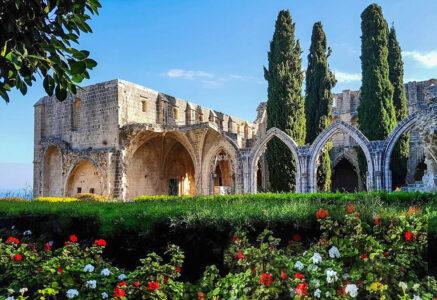
Photo of Bellapais Abbey
Bellapais Abbey, a gem in Northern Cyprus, is a testament to medieval craftsmanship and tranquility. Built in the 13th century, it sits atop Bellapais village, offering breathtaking views over Kyrenia and the Mediterranean.
This historic site, now a museum, doubles as a cultural hub, hosting concerts and a music festival in its Gothic refectory. Visitors can enjoy dining within its ancient walls, experiencing a blend of local and international flavors. Open year-round, with seasonal hours, it charges an admission of 15 TL. The Abbey remains a serene retreat, inviting exploration and inspiration from its panoramic perch.
Interesting fact about place
The etymology of Bellapais Abbey adds a layer of intrigue to its history. Originally known as Abbaye de la Paix (“Abbey of Peace”) in French, the name underwent a transformation with the Italian takeover, eventually being known as “Bellapais,” a nod to the Italian Bella Paese, meaning “Beautiful Land.” This name perfectly encapsulates the essence of Bellapais Abbey, a sanctuary of peace and beauty, inviting all who visit to immerse themselves in its timeless allure.
2. Kyrenia Castle, Kyrenia

Photo of Kyrenia Castle
Kyrenia Castle, standing at Kyrenia’s old harbour in Northern Cyprus, is a fortress with roots in Roman times, showcasing Cyprus’s layered history. This strategic site, fortified by the Venetians in the 16th century over a Crusader structure, has been a guardian of the port since its inception. Its architecture, initially bolstered during the Byzantine era with four towers and expanded by the Lusignans, was significantly remodeled by the Venetians, highlighting its maritime importance.
Today, Kyrenia Castle serves as a gateway to Cypriot history, offering visitors insights into the island’s past and cultural influences. Open Monday through Saturday from 8 AM to 6 PM, the castle invites exploration of its ramparts, Shipwreck Museum, and breathtaking views, making it a key destination in Northern Cyprus.
Interesting fact about place
One of the castle’s most captivating features is the Shipwreck Museum, housed within its ancient walls. This museum is home to one of the most significant and well-preserved pieces of marine archaeology in the world. Visitors to the museum can marvel at the ancient shipwreck, a silent narrator of the maritime history that has been integral to Cyprus’s development.
3. Selimiye Mosque, Nicosia

Photo of Selimiye Mosque
The Selimiye Mosque in North Nicosia, originally the Cathedral of Saint Sophia, stands as a beacon of the cultural and religious fusion that defines Cyprus’s history. This largest and oldest surviving Gothic church in Cyprus, with its impressive dimensions and capacity to hold 2500 worshippers, reflects the island’s historical transitions from Christian cathedral to mosque.
Its architectural design, inspired by notable European cathedrals and modified with the Ottoman Aziziye Gate, showcases the confluence of medieval European and Ottoman influences. Serving as a significant place of worship and a symbol of architectural marvel, the Selimiye Mosque embodies Cyprus’s rich historical tapestry.
Nowadays, it invites visitors to explore its grandeur and delve into the diverse cultural heritage that has shaped the island, making it a must-visit place in Northern Cyprus.
4. Saint Hilarion Castle, Kyrenia
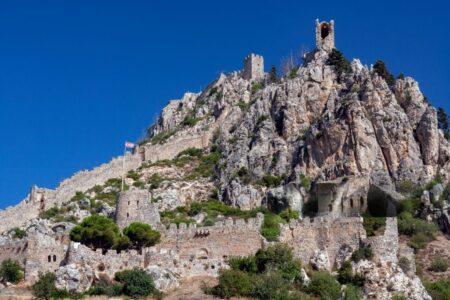
Photo of Saint Hilarion Castle
Saint Hilarion Castle, perched in the Kyrenia mountain range of Northern Cyprus, stands as a testament to the island’s rich history and the best-preserved ruin among its ancient strongholds. Originating in the 11th century as a Byzantine effort to ward off Arab raids, it served a vital role in defense alongside Kantara and Buffavento castles.
Under the rule of the Lusignan dynasty, it evolved into a royal summer retreat and a significant site in the political turmoil of the era, notably the clash between Frederick II and John d’Ibelin.
Open daily from 9 AM to 4 PM, Saint Hilarion Castle invites visitors to traverse its ruins, offering an immersive journey into a past where history and myth intertwine, making it an essential destination for travelers and history enthusiasts.
Interesting fact about place
Its compelling history and architectural grandeur have captured the imagination of authors and creators, featuring in works like Leon Uris’s “Exodus” and video games such as Assassin’s Creed: Bloodlines.
5. Kantara Castle
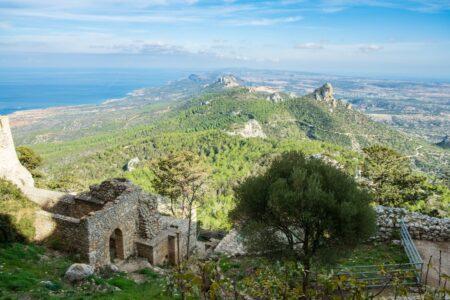
Photo of Kantara Castle
Kantara Castle, located in Northern Cyprus, is a historic fortress with origins likely in the Byzantine period, marked by a mix of Byzantine and Frankish architecture. It played a critical role in the island’s defense system alongside Buffavento and St. Hilarion Castles, primarily serving as a watchtower and administrative center. Captured by Richard the Lionheart in 1191, it later became part of the Lusignan dynasty’s domain, undergoing expansions to enhance its military capabilities.
Despite its strategic importance, the castle was declared obsolete by 1519 and dismantled in 1560. Restoration efforts in the early 20th century have preserved it as a significant cultural heritage site. Its architectural features, including twin towers, a barbican, and several cisterns, reflect its historical military significance and the cultural amalgamation of its era.
Today, Kantara Castle is a prominent historical site, offering insights into Cyprus’s layered past and stunning views from its mountainous vantage point.
6. Buffavento Castle, Kyrenia
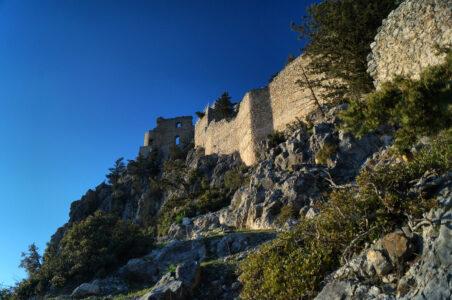
Photo of Buffavento Castle
Buffavento Castle, positioned in Northern Cyprus, dates back to the Byzantine period, showcasing a blend of Byzantine and Frankish architectural styles. It served as part of a defensive axis alongside St. Hilarion and Kantara Castles, mainly functioning as a watchtower against pirate raids and a prison, with minimal combat involvement. The castle’s name, meaning “Defier of the Winds” in Italian, reflects its commanding position at 960 meters above sea level, accessible only via 600 steps and surrounded by steep cliffs, making it a formidable fortress.
Captured by Richard the Lionheart in 1191, Buffavento later became part of the dominion of the Lusignan dynasty, which used it sporadically as a prison. By the 14th century, under Venetian control, the castle fell into disuse and eventually became derelict. The architecture lacks decorative elements, utilizing limestone and mountain stones, with the castle divided into two wards connected by a long staircase, now destroyed. Notable features include a large water cistern, stable, and gates within a two-story tower with a Frankish arch.
7. Büyük Han, Nicosia
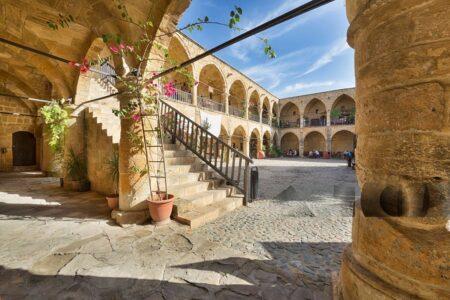
Photo of Büyük Han
Büyük Han, located in the capital of Cyprus, is the largest caravansarai on the island, built by the Ottomans in 1572. This architectural marvel, originally constructed to serve the needs of travelers and merchants, stands as a testament to the rich history and cultural amalgamation of Cyprus. Over the centuries, Büyük Han has transitioned from a bustling inn to the first city prison under British administration, and after a period of restoration in the 1990s, it has been revitalized as a vibrant arts center.
Currently, Büyük Han serves not only as a reminder of Cyprus’s Ottoman past but also as a lively cultural and commercial space, where traditional Cypriot handicrafts are sold, and the spirit of creativity is fostered. This transformation from an inn to a prison and finally to a center for arts and culture speaks volumes of the adaptive reuse of historical buildings in preserving and celebrating cultural heritage.
Today, Büyük Han is home to several galleries, workshops, courtyard cafes, and souvenir shops, making it a hub for arts and culture. The central feature of this historic inn is a mosque with a fountain, highlighting its original purpose for travelers to perform ablutions before prayers. The architecture of Büyük Han combines elements from both Byzantine and Frankish styles, with a large inner courtyard surrounded by rooms with colonnades and cross vaults. The inn offers 68 rooms across two floors, historically designated for commerce and accommodation, alongside 10 one-story shops at the eastern entrance.
8. Apostolos Andreas Monastery, Rizokarpaso

Photo of Apostolos Andreas Monastery
Apostolos Andreas Monastery, located at the north-easternmost point of Cyprus in Rizokarpaso on the Karpass Peninsula, is a revered site dedicated to Saint Andrew. Known as “the Lourdes of Cyprus,” it attracts both Greek Cypriot and Turkish Cypriot pilgrims for its historical and religious significance. The monastery’s origins are linked to a miracle by Saint Andrew, who, upon striking rocks with his staff, caused a healing spring to gush forth. This event marked the site as a pilgrimage destination, with the current church dating back to the 18th century and the main buildings to the 19th century.
Despite its rich history, the monastery faced neglect, particularly after the 1974 Turkish invasion, which reduced the number of pilgrims. However, the opening of crossing points in 2004 has seen a resurgence of visitors. Restoration efforts have been underway, coordinated by a bi-communal technical committee established in 2008 to protect Cyprus’s cultural heritage. After initial reluctance due to ownership disputes, the Church of Cyprus, the Turkish Cypriot EVKAF religious foundation, and international donors, including USAID, have contributed to the monastery’s restoration, amounting to more than 5 million euros.
Today, Apostolos Andreas Monastery stands not only as a monument of faith and healing but also as a symbol of bi-communal cooperation and cultural preservation in Cyprus.
9. The Walled City of Famagusta, Famagusta
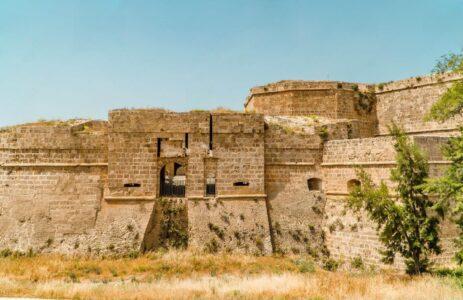
Photo of The Walled City of Famagusta
The Walled City of Famagusta, nestled on the eastern coast of Cyprus, stands as a testament to the island’s rich and diverse history. Dating back to the 3rd century B.C., this historic fortress city has played a pivotal role in the Mediterranean’s trade and military strategies, drawing merchants, crusaders, and conquerors to its harbors.
As a cultural melting pot, Famagusta has seen the rise and fall of many empires, from the Byzantines to the Venetians, and later the Ottomans, each leaving a distinct mark on the city’s architectural and cultural landscape. The fall of Acre in 1291 marked a significant turning point, transforming Famagusta into a crucial commercial hub, rivaling the grandeur of Constantinople and Venice.
The city’s streets, a mosaic of history, are lined with remnants of its glorious past: from grandiose churches that once echoed with the coronations of Jerusalem’s kings to the serene Ottoman mosques symbolizing centuries of cultural synthesis. The sea wall and fortress, immortalized by Shakespeare in Othello, continue to guard the city’s ancient secrets, offering visitors a glimpse into a bygone era.
Today, the Walled City of Famagusta invites explorers to wander its quaint streets, delve into its museums, and marvel at the cultural heritage sites. It’s a place where history coexists with the vibrancy of Cypriot hospitality, where every corner, cafe, and stone tells a story of resilience, diversity, and the enduring spirit of its people. Visitors are welcomed to immerse themselves in the legacy of this legendary city, experiencing firsthand the historical tapestry that makes the Walled City of Famagusta a treasure of the Mediterranean.
Cape Greco, situated at the southeastern tip of Cyprus, marks the easternmost point of both the Republic of Cyprus and the European Union. This stunning headland, part of Ayia Napa Municipality, is nestled between the tourist resorts of Ayia Napa and Protaras, drawing visitors with its breathtaking natural beauty and the allure of the legendary ‘Ayia Napa sea monster’.
10. Cape Greco, Ayia Napa

Photo of Carpe Greco
Designated as an Important Bird Area (IBA) by BirdLife International, Cape Greco is a critical migration site for numerous bird species, including red-footed falcons, pallid harriers, honey buzzards, and common kestrels. It also supports breeding populations of Cyprus wheatears, Cyprus warblers, and black francolins. Despite its status as a National Forest Park and the efforts of the Forestry Department of the Cyprus Ministry of the Interior to protect it, the bird populations at Cape Greco face threats from illegal trapping.
Today, Cape Greco remains a cherished destination for its panoramic views, serene environment, and rich biodiversity, inviting exploration and appreciation from nature enthusiasts and history buffs alike.
Interesting fact about place
Cape Greco has also played a significant role in international broadcasting. It was home to a powerful mediumwave broadcasting station operated by Radio Monte Carlo, targeting audiences in the Middle East and Northern Africa with French- and Arabic-language programs.
11. Coral Bay, Peyia
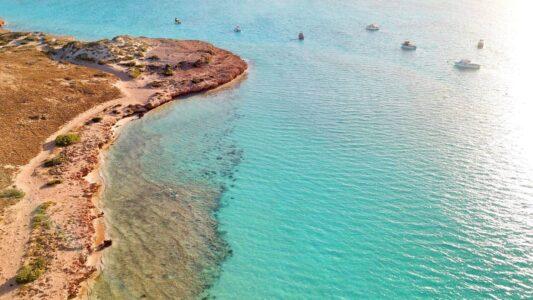
Photo of Coral Bay
Coral Bay, nestled within the Peyia municipality and situated 11 km north of Paphos, stands as a premier tourist destination renowned for its picturesque beauty and inviting atmosphere. This coastal haven is characterized by its stunning natural landscape, marked by rocky headlands and captivating sea caves that frame the area’s main attraction: a 600m crescent of soft white sand, making it a perfect retreat for beach lovers.
The beach at Coral Bay is distinguished by its EU Blue Flag certification, a testament to its high environmental and quality standards. This recognition assures visitors of clean, safe waters and well-maintained facilities, adhering to the stringent criteria set by the European Union. The Blue Flag status is a guarantee that Coral Bay meets all the necessary conditions for sustainability, safety, and accessibility, making it an ideal choice for families, couples, and solo travelers alike.
Adding to the charm of Coral Bay is Potima Bay, another beautiful beach located about 1.5 km away, near the edges of Kissonerga village. This area provides a more secluded alternative for those looking to explore beyond the main beach, offering tranquil settings against the backdrop of Cyprus’s stunning coastal landscape.
Coral Bay’s allure is not just limited to its natural beauty; the area is also equipped with a variety of amenities and activities to enhance the visitor experience. From water sports to leisurely dining options along the beachfront, Coral Bay caters to all preferences, promising a memorable stay for all who visit this coastal paradise.
Caledonia Waterfalls, also known as Kalidonia Waterfalls, is a majestic natural landmark discovered by a Scottish expedition in 1878, nestled in the Platres region of Cyprus. The waterfall’s name, ‘Caledonia,’ is derived from the ancient Latin name for Scotland, chosen due to the waterfall’s striking resemblance to the Scottish landscape. This beautiful cascade falls from a height of 12 meters and is surrounded by lush forests and native wildflowers, offering a breathtaking spectacle in any season.
12. Caledonia Waterfalls
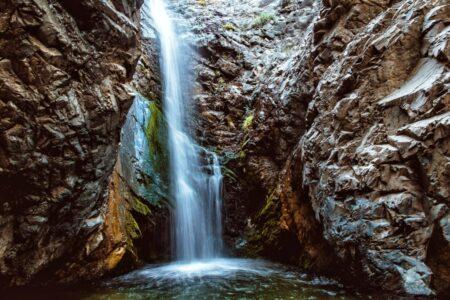
Photo of Caledonia Waterfalls
The journey to Caledonia Waterfalls is an adventure in itself, with two main routes available for visitors. The first is a shortcut from Aeodion road through the Psilo Dendro Trout Farm, bypassing the nature trail. However, for those wishing to immerse themselves in the natural beauty of the area, a more scenic route starts from a parking area near the ‘Psilo Dendro’ or Tall Tree. The trail, which can be slippery after rain or snow, takes between 1.5 and 2.5 hours to complete and is considered to have an average difficulty level.
Hiking boots are recommended, especially in wet conditions, to safely navigate the rocky and potentially slick parts of the path.
Located approximately 2 km north of Pano Platres village and 3 km from Troodos square, Caledonia Waterfalls holds the distinction of being the highest waterfall on the island. It’s a popular destination for hiking and walking enthusiasts from March to October, and dogs are also welcome on the trail. Recognized for its stunning beauty, the waterfall was ranked by Business Insider as the 14th Best waterfall in Europe.
Whether you’re drawn by the allure of the falls themselves or the serene hiking experience through Cyprus’s verdant landscapes, Caledonia Waterfalls offers a refreshing escape into nature’s embrace.

